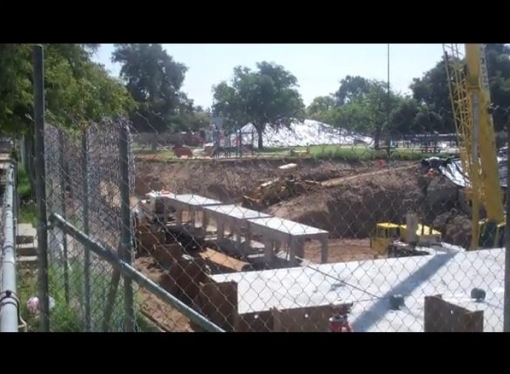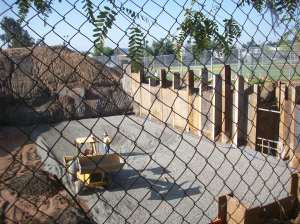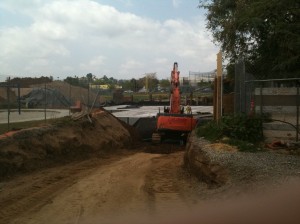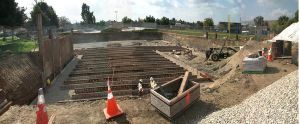The Highland Park-Mount Washington Patch posted video footage of the installation of the retention basins in April.
Video Footage of Garvanza Park Construction Work
9 06 2011Comments : Comments Off on Video Footage of Garvanza Park Construction Work
Tags: Garvanza
Categories : Watershed
Garvanza Park BMP Update
24 05 2011The Garvanza Park Stormwater BMP Project is an innovative project that will capture and clean more than one million gallons of rain and runoff. Please see our March post.
The infiltration basins were placed underground in March, and excavation began for the retention basins. Upon completion, stormwater will be stored in these retention basins and used for subsurface irrigation of this area.
A base of gravel is spread over the area where the retention chambers will sit. A geotextile fabric material will be laid down, over which a thick waterproof pond liner will be put down. The retention chambers will be placed over these layers.
Towards the left-hand side of the above photo, part of the buried infiltration basins can be seen. The retention basins are visible in the background of the excavated area.
In the above photo, the retention basins are installed and will be buried underground. The next step is to install the Continuous Deflective Separation (CDS) units. A CDS unit is a specially-designed concrete sump unit that separates out sediment, trash, oil, and grease, while it filters the stormwater that is diverted into the retention and infiltration basins.
Once the park’s surface is restored, North East Trees will install a subsurface irrigation system using the water stored in the basins to irrigate parts of the park. Water-thirsty turf grass will be replaced with a drought-tolerant species of buffalo grass, and native trees will be planted throughout the park. This work will start in June of this year and the establishment of the new plant material will continue through December 2011.
Comments : Comments Off on Garvanza Park BMP Update
Tags: Garvanza
Categories : Watershed
Garvanza Park BMP Update
29 03 2011The Garvanza Park Stormwater BMP Project is an innovative project that will capture and clean more than one million gallons of rain and runoff. During the month of January, once the shoring and stabilizing of the site was done, excavation of the soils began. The soil is being removed to an approximate depth of 18 feet. This large area is graded flat at the bottom and during February the crew placed large forms for concrete footings. In the area that is now excavated there are alternating rows of concrete being poured, with gravel between the rows of concrete. Large infiltration basins will be placed onto these footings and will allow for the stormwater to infiltrate into the soil.
The excavated area seen in the photo above is almost as wide as a football field and half a football field in length.
The individual infiltration basin units are being set onto the gravel and concrete footings, the units are set side by side and sealed. The storm water that enters the infiltration basin will gradually seep into the ground and replenish the groundwater.
The infiltration basins have been covered in soil and excavation for the next set of basins has begun. The basins will be buried underneath a grassy field in the park. The next set of basins to be installed will be the retention basins that will contain the stormwater to be used for irrigating the field.
Comments : Comments Off on Garvanza Park BMP Update
Tags: Garvanza
Categories : Uncategorized, Watershed
Garvanza Park Stormwater BMP Project
14 01 2011North East Trees in co-ordination with the City of Los Angeles, Bureau of Sanitation is working on the design and construction of this innovative project that will have the capacity to capture and clean more than one million gallons of rain and rainwater runoff.
Project Budget: $3.1 million
Project Description: A large storm drain passes under Garvanza Park (located at 6240 E. Meridian Street, Los Angles, CA 90042) that carries all the water draining from the hilly neighborhood above it directly to the Arroyo Seco. Typically, this urban rainwater runoff carrying oil and other pollutants from the streets travels to the Los Angeles River and finally empties into the ocean.
This “Best Management Practices” project (BMP) will capture rain water and divert the polluted rainwater runoff into two large cisterns that will be installed under the park. Water will be cleaned and filtered utilizing natural infiltration processes. Water collected in one chamber will be allowed to soak into the soil replenishing the groundwater. The other chamber will store water that will be used to irrigate the park during the dry months.
Ultimately, this project will help save water, as well as keep the Arroyo Seco, Los Angeles River and the ocean healthy and clean.
Project Update: The design phase is complete, and construction started on November 8, 2010. The construction site has been fenced in and safely secured while leaving the skate park, playground equipment and baseball field still accessible to the community. Park trees have been protected from construction activities with fencing and a cushion of mulch around them.
There are various stages of construction that the park will go through; from shoring and excavation to irrigation installation and landscaping.
Currently the project is in the shoring stage. Large holes have been bored into the ground around the perimeter of where the basins will be installed, beams over 30 feet long are anchored in the holes, the earth has been excavated from this area and large steel plates have been attached to the beams to create walls around the excavated area. This creates space for the basins. The basins will be buried under the park at a depth of 18 feet.
Construction is scheduled to continue through summer of 2011. NET will be providing updates and ongoing photo documentation to the activities on site. Be sure to check back on our progress.
Funding for this project has been provided by state and local funds.
Comments : Comments Off on Garvanza Park Stormwater BMP Project
Tags: Garvanza
Categories : Watershed











